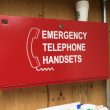Apparent D Block reallocation marks the beginning, not the end, of public safety’s work
Last week, U.S. Homeland Security Secretary Janet Napolitano declared that the public-safety sector will be getting the D Block, the 10 MHz of spectrum in the 700 MHz band that currently is scheduled to be auctioned to commercial interests. President Obama is on board with the idea. The airwaves, which were vacated by over-the-air broadcasters four years ago, would be paired with 10 MHz of adjacent spectrum in the band that already is possessed by public safety. The thinking is that the combined 20 MHz of spectrum would meet the sector’s needs for decades to come. Federal legislation is pending to make this a reality.
Being the optimistic sort that I am, I expect this to happen, as it makes little sense to do anything else. As I previously have written, America needs more cell-phone apps like our prison system needs more inmates. What America does need — desperately — is the best first-responder communications system that money can buy. Soon, we will be commemorating the 10th anniversary of the Sept. 11, 2001, terrorist attacks. And, though we have been fortunate to avoid a major attack on our soil in the ensuing years, attempts have been made and thwarted. The threat remains very real, hanging over our heads like the sword of Damocles.
Not only that, but America also tends to experience its fair share of natural disasters, such as the major blizzard that is dropping up to two feet of snow along a path that stretches from Oklahoma City to Bangor, Maine. It is predicted that this storm — potentially life threatening, in the words of some officials — will affect two dozen states and more than 100 million citizens. When major disasters such as this occur, first responders need better communications than is at their disposal today. Reallocating the D Block to public safety, which will enable the next-generation revolution to begin in earnest, represents a quantum leap towards that goal.
But it only is the first step in what still will be a very long journey. The next big leaps concern securing the funding needed to build the nationwide broadband network, and then actually deploying it. Regarding the latter, the hiccups that occurred in the San Francisco Bay Area, which is attempting to build public safety’s first 700 MHz broadband network, demonstrate that such deployments won’t be easy. Rather, they will be fraught with political and logistical challenges that promise to be daunting. This will be true of every jurisdiction, from coast to coast. Hopefully, the early adopters will blaze trails that will ease those challenges for those who follow.
Before that can happen, funding needs to be locked down, and this likely will be even more daunting than securing the D Block — and think about that for a moment. Getting Congress to reverse course and abandon the idea of auctioning this spectrum — which would have put substantial dollars into the U.S. Treasury — is a monumental achievement that is the public-safety sector equivalent of NASA landing man on the moon.
It should be celebrated, but only for a few moments. Because the reality is that, without adequate, sustained funding, public safety’s dream network never will come to fruition and the effort to secure the D Block ultimately will be for naught.
I think that the funding ultimately will be secured, if for no other reason than Congress understands that reallocating the D Block to public safety would be pointless if this network never is built. Indeed, my greater fear is that Congress and public safety’s leaders, as they focus on making this vital network a reality, will forget about another crucial aspect of first-responder communications that also desperately needs funding.
The 911 sector sorely needs financial help and deserves to receive it. Forget about migrating to next-generation 911 — some centers are struggling just to maintain basic operations. That is absurd. Emergency response starts with 911 call-takers and dispatchers, who have to make life-and-death decisions under the most trying of circumstances. It can be well argued that the 911 emergency center is the hub of the first-response wheel and should be treated as such.
If the federal government and public-safety’s leaders truly want to bring first-responder communications into the future, then they both need to think holistically and ensure that the 911 sector also migrates to next-generation technology, in lock step with police, fire and emergency medical. For without the hub, there is no wheel.
What do you think? Tell us in the comment box below.
For more information, attend sessions on broadband, next-generation networks and 700 MHz at IWCE in Las Vegas, March 7-11, 2011.

















